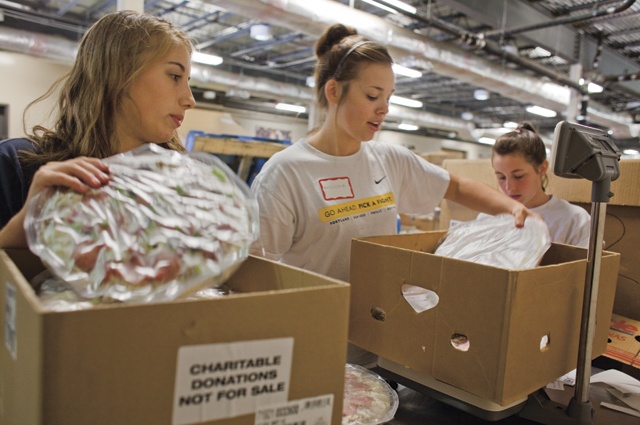Have you ever watched your local grocer removing unsold produce and wondered where the food was going next? Food manufacturers stamp canned goods with guidelines indicating optimum shelf life. At that point, products are removed even though they are still nourishing. There are also purely cosmetic concerns: If a can is dented or a label torn, out they go. Customer returns are usually not reshelved. A perfectly good head of lettuce with a few bruised leaves is removed from its misted, refrigerated manger. Seasonal promotional items disappear after a holiday.
A well-organized grocery store donates such products to food banks instead of sending them to the landfill. In fact, an elaborate national network has developed over the past three decades to get surplus foods to people who are hungry. Now called Feeding America, it was organized in 1979 as America’s Second Harvest. The idea was to enlist food growers, distributors, retail grocery stores and food processors to work at the highest levels to collect nutritious surplus food and tax-deductible products. It has turned out to be a win-win proposition for all involved. Food bank personnel add that in recent years, grocery stores have made great advances in waste reduction.
Feeding America’s role usually ends before food is distributed. Nineteen food banks in Texas with refrigeration and warehousing collect, store and distribute the surplus. Feeding America’s first major partner in Texas was H-E-B groceries. The Texas-based chain has now expanded its food charities into Mexico. In addition, most all the large grocers are linked up to the surplus chain.
It’s usually up to a big-city food bank to pick up large food donations from participating grocers. They follow the same strict food-handling guidelines as wholesale and retail facilities. Meticulous records must be kept, particularly when it comes to meat and poultry donations.
Many grocery stores offer shoppers the option to donate $1 or more to a food charity or to purchase food and leave it for distribution.
“Twenty years ago, food banks mainly received staples,” said JC Dwyer, state policy director for the Texas Food Bank Network. “Now, more food pantries can handle a variety of fresh goods. But infrastructure is still a problem.” Food distribution facilities—food pantries and food kitchens—in small towns and rural areas still handle mainly staples, although food bank officials say there are grants available to upgrade local storage facilities with refrigeration and kitchen equipment.
But even this evolved food distribution system relies on ground-level people to keep the process humming. Adrienne Longenecker, chief development officer of the Capital Area Food Bank of Texas, says the effectiveness of a single store’s recycling process usually can be traced back to a single dedicated employee who takes responsibility for seeing that “sell by” dates are carefully monitored, that waste is reduced to a minimum in the store, and surplus food is made available to a food bank. They deserve recognition for going the extra mile.
——————–
Kaye Northcott is editor emeritus of Texas Co-op Power.

